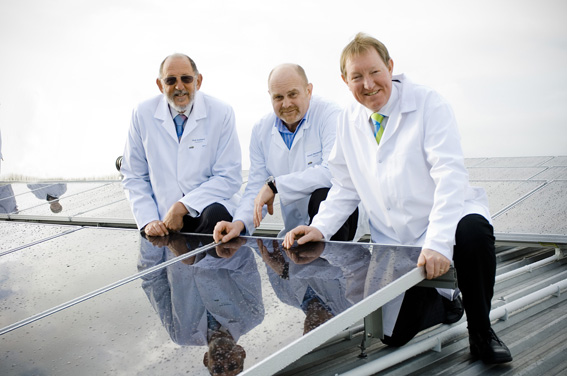4.5 billion year old power station powers up commercial initiative
 The largest commercial installation in New Zealand of thin film solar panel technology has been activated at Hubbard Foods in Mangere, Auckland.
The largest commercial installation in New Zealand of thin film solar panel technology has been activated at Hubbard Foods in Mangere, Auckland.
This installation, which is a joint initiative between infrastructure company Vector and cereal maker Hubbards, is the first commercial enterprise of its size to use second generation thin film solar panels.
Combined, the 160 solar panel installation covering 227.5m2 will generate 29,000 kW/h of electricity per annum and will be used to power the lighting for Hubbards’ finished goods warehouse.
This is equivalent to the power used to produce 169,000 packets of cereal or the amount of electricity consumed by 3.5 homes over the course of a year.
“A significant feature of these new generation panels is that they continue to perform, even if it is a cloudy day. This is a key difference with first generation crystalline solar panels which have considerably reduced capacity when the sun isn’t shining,” says Hubbard’s CEO Doug Paulin.
“This feature is a decided advantage for a business based in Auckland, which is not known for being the sunniest city in New Zealand.
Vector CEO Simon Mackenzie says this initiative could signal a new chapter of solar panel usage by commercial businesses and describes it as an example of developing technology that in the future could lead to power at a lower cost.
“While this solar PV installation is not designed to power Hubbards whole business, the savings still count. The added advantage is the new thin-film technology makes them lower cost per watt, easy to install and maintain.”
Mr Mackenzie also emphasised the opportunity the initiative provided for Vector in understanding the effect of distributed solar PV systems on its electricity network.
“In particular we want to ensure that our network can support this technology into the future,” he says.
“This is not a short term commitment to our sustainable business practices,” says Hubbards’ business founder and Chairman, Dick Hubbard. “In 20 years time, these panels will be functioning at similar levels they are today.
“As a business, Hubbards is committed to harnessing the natural resources available to us, and re-using it for commercial operations where possible. Down the line we hope initiatives like these will make sufficient savings we can then invest back into the business, but right now it’s about setting a commercial benchmark from which others can aspire to follow.”
The solar panels were officially activated this morning at Hubbard’s Mangere warehouse by the Minister for the Environment, Hon. Dr Nick Smith.
Key Facts:
Combined, the 160 solar panel installation covering 227.5m2, will generate 29,000 kW/h of electricity per annum and will be used to power the lighting for Hubbard’s finished goods warehouse in Mangere.
The amount of energy generated by the panels is equivalent to the power used to produce 169,000 packets of cereal or the amount of electricity consumed by 3.5 homes over the course of a year.
The 20kW system will produce enough electricity to displace about 6.5 tonnes of CO2 gas that would have been otherwise produced from grid generated electricity. This equates to the amount of greenhouse gas an average vehicle produces in travelling 60,000km.
Thin film solar panels are made of a lightweight and flexible material, allowing them to be manufactured in long, continuous rolls, or incorporated into materials such as laminates, shingles, and roofing tiles. For this project at Hubbard’s, because of the slope of the roof, the panels have been put in frames to achieve a higher elevation.
nextSTEP Visit: www.vector.co.nz/solarpower



